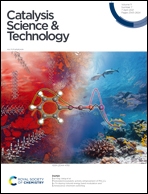Photo(electro)catalytic activity enhancement of PhC2Cu by Fe doping induced energy band modulation and luminescence chromism switching†
Abstract
In this work, iron doping was proposed to improve the photo(electro)catalytic activity of PhC2Cu, an air stable metal–organic coordination polymeric photocatalyst. After displacement of partial Cu atoms by Fe, the energy band structure of PhC2Cu was successively modulated, featuring a narrowed band gap and down-shift in the valence band towards a more positive potential. More interestingly, the luminescence chromism upon iron doping is indicative of inhibited ligand-to-metal charge transfer (LMCT) that is relevant to the recombination of photocarriers. When the mole ratio of Fe/Cu reached 2%, the photocurrent density achieved its maximum, which was 4 times higher than that of the PhC2Cu photocathode, consistent with an enhanced separation of electron–hole pairs. Furthermore, the extremely negative conduction band potential of PhC2Cu enabled efficient O2 activation, generating a series of reactive oxygen species (ROS) for the degradation of organic pollutants. The rate of methyl orange (MO) and 2,4-dichlorophenol (2,4-DCP) degradation over 2% Fe–PhC2Cu increased by 2 and 1.6 times. This study provides a promising strategy for improving the activity of metal–organic photocatalysts.



 Please wait while we load your content...
Please wait while we load your content...